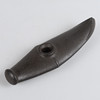
BOAT AX in black polished rock, Younger Stone Age.
This auction is closed, but maybe you like the following items?





Description
Boat ax in black polished rock with center seam on top, underside with center seam at shaft hole and seam at egg.
Provenance: find area Västergötland Length approx. 22.2 cm, width approx. 8 cm, shaft hole diameter 22 mm Note. The battle ax culture, also known as the boat ax culture in the literature, denotes a cultural group occurring mainly from southern Norway and southern Sweden, including Uppland. It is a regional variant of the so-called Corded Ware culture that occurs in Northern and Central Europe during the third millennium before Christ. C14 dating of graves dates the phenomenon to about 2,950-2,300 BC, but in some regions of the continent it disappears earlier. There are few dates from Sweden, but the oldest end up around 2,900-2,800 BC.
In its oldest stage, a type of so-called battle axe, similar to the oldest ax type of the Swedish-Norwegian subgroup, occurs in all string ceramic groups in Europe. In later stages, there are few battle axes in the central European areas, as they are numerous in the northern and eastern areas. The battle axes were probably not used as weapons, but had a more symbolic function.
Condition
Minor edge damage at edge.
Theme
Do you have something similar to sell? Get your items valued free of charge!
Bidding
Have your item valued free of charge.
Bid history
| 3 | 19 Jun, 10:00 | 12 774 EUR |
| 9 | 19 Jun, 09:59 | 11 861 EUR |
| 3 A | 19 Jun, 09:59 | 11 861 EUR |
| Show all 47 bids | ||
Description
Boat ax in black polished rock with center seam on top, underside with center seam at shaft hole and seam at egg.
Provenance: find area Västergötland Length approx. 22.2 cm, width approx. 8 cm, shaft hole diameter 22 mm Note. The battle ax culture, also known as the boat ax culture in the literature, denotes a cultural group occurring mainly from southern Norway and southern Sweden, including Uppland. It is a regional variant of the so-called Corded Ware culture that occurs in Northern and Central Europe during the third millennium before Christ. C14 dating of graves dates the phenomenon to about 2,950-2,300 BC, but in some regions of the continent it disappears earlier. There are few dates from Sweden, but the oldest end up around 2,900-2,800 BC.
In its oldest stage, a type of so-called battle axe, similar to the oldest ax type of the Swedish-Norwegian subgroup, occurs in all string ceramic groups in Europe. In later stages, there are few battle axes in the central European areas, as they are numerous in the northern and eastern areas. The battle axes were probably not used as weapons, but had a more symbolic function.
Condition
Minor edge damage at edge.
Theme
Do you have something similar to sell? Get your items valued free of charge!






















